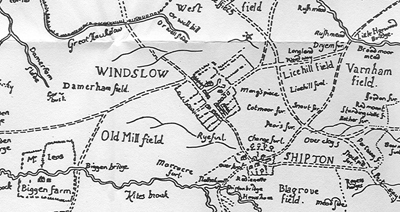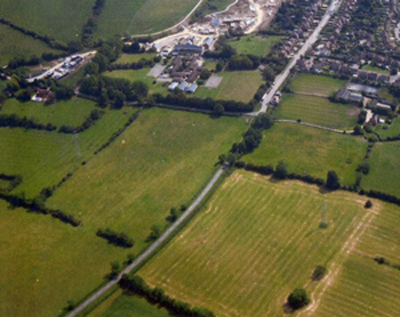
Enclosure
The open field system lasted from (probably) the 10th century to the 18th: see Farms for more information. Farmers lived in Winslow and Shipton and went out to work their land which was in strips scattered around the ridge and furrow in the 3 huge (200-300 acres) fields of Winslow and 3 fields of Shipton. They had rights to graze their animals in the harvested and fallow fields, and shared in the areas of permanent meadow, with access to 'common' land to gather fuel etc. Open fields were suitable for intensive arable farming. The system gave farmers holdings among the best and worst land, but it was considered inefficient in the 18th century. It was also not designed for large-scale livestock farming, which was becoming more attractive from at least the 16th century, and there was some piecemeal enclosure, especially of the land nearest to the houses.  A document from c.1635 shows the development of leys, i.e. areas of arable land turned over to grass. When Henry Watts was assaulted by 41 men and had his hedges pulled down at Cowmead Close, c.1524, it may have been a protest against an early enclosure, but the close is shown on the Fortescue map of 1599, which also depicts a whole enclosed farm at Biggin (see right). A large section of Red Field in Shipton was converted to the Cowpasture, and William Lowndes in 1703 refers to a number of "new closes", which were evidently more valuable than land in the open fields.
A document from c.1635 shows the development of leys, i.e. areas of arable land turned over to grass. When Henry Watts was assaulted by 41 men and had his hedges pulled down at Cowmead Close, c.1524, it may have been a protest against an early enclosure, but the close is shown on the Fortescue map of 1599, which also depicts a whole enclosed farm at Biggin (see right). A large section of Red Field in Shipton was converted to the Cowpasture, and William Lowndes in 1703 refers to a number of "new closes", which were evidently more valuable than land in the open fields.
- There is a BBC Radio 4 In Our Time programme on enclosure which gives a good introduction to enclosure by Act of Parliament in the 18th century.
Parliamentary enclosure required the owners of a majority of the land to seek an act of Parliament, which set up a commission. After extensive surveying, new holdings were awarded to the landholders, roughly in proportion to their old holdings. In Winslow and Shipton the owners of the tithes, the Lowndes family, also received land in return for exstinguishing the tithes, which meant that everyone else ended up with less land than they held before (usually between half and two-thirds). New landholders were required to fence and hedge their holdings, and to pay the expenses of surveyors, solicitors and commissioners, all of which was prohibitively expensive for some people who had to sell up before or after enclosure.
The whole enclosure process in Winslow was clearly instigated by the Lowndes family. William Lowndes was thought to be interested in it 30 years before it actually happened.
Verney Papers (CBS M11/56, image 248)
21 Oct 1716: Viscount Fermanagh, Claydon, to Hon. Ralph Verney
Old Lowndes hath bought Mrs Falls estate at Barton for his youngest son Joseph, he hath also bought 2 or 3 farmes at Shipton (near Winsloe) so that now he hath almost all Shipton which people say he designs to Inclose, I think Dr B [Busby of Addington] did wrong not to buy somewhat in Shipton to prevent inclosing …
Richard Lowndes of Winslow was in a particularly good position to promote enclosure as MP for Bucks 1741-74. The enclosure of Shipton in 1745 was one of the earliest parliamentary enclosures in Bucks. Lowndes went from holding less than half the land in the parish of Winslow before enclosure to two-thirds afterwards. A list of tenants in Winslow, c.1743, shows that before enclosure he held 627 out of 1404 acres (these were evidently smaller than the "parliamentary acres" used for enclosure). There are 44 tenants of land in the list; after enclosure there were 31, even before the unviable holdings were sold, and the Lowndes family now had 707 acres out of just over 1,100.
Read the full details of the enclosure awards, with clickable maps to show who received which land, and how the Lowndes' holdings expanded:
Enclosure created the system of small fields and hedges which can still be seen today, and also most of the present-day network of footpaths, some of which replaced earlier tracks or roads:
 |
The photo shows Verney Road running into Winslow from the west. On the right the land was allocated to the church (it became Glebe Farm much later). On the left is the field allotted to Elizabeth Mayne. You can see how the hedges were imposed on the existing ridge and furrow, which survived enclosure because the land was used for grazing but is now disappearing under the new housing developments. |
Although some farmers continued to operate from farmhouses in Winslow and Shipton at first, only Rands Farm has remained in agricultural use. The Lowndes family built new farmhouses for tenants in the middle of the land associated with them, including:
There is more about the effects of enclosure on agriculture in the Farms section. The other social effect was the disappearance of what remained of the class of independent smallholders (already very much in decline), who had been able to make a living from a fairly small amount of land with traditional rights of common, pasture, etc., perhaps supplemented by some labour for wages or small-scale business activity. After enclosure (although not necessarily immediately after), there was much more polarisation between farmers with a substantial holding of land, either in their own right or rented from the Lowndes family, and the landless labourers who worked for them, or who moved away because they could not find work.
See also:
- Arthur Clear, A Thousand Years of Winslow Life (1888): Enclosure
- Michael Reed, "Enclosure in North Buckinghamshire, 1500-1750", Agricultural History Review 32 (1984), 133-144
- M.E. Turner, "Parliamentary enclosure and landownership change in Buckinghamshire", Economic History Review, New Series 28, (1975), 565-581
